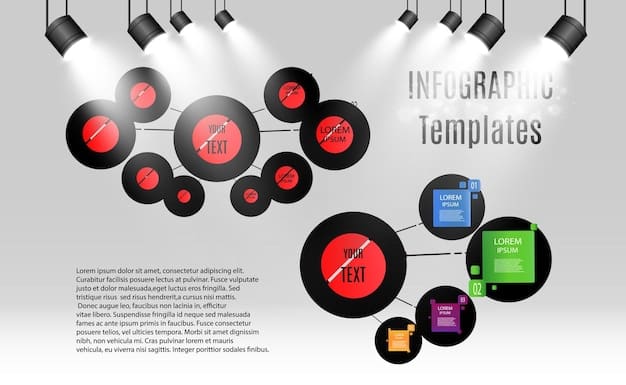Podcast Content Repurposing in 2025: Maximizing Your Reach

Podcast content repurposing in 2025 is about strategically transforming your podcast episodes into various formats, such as blog posts, social media snippets, videos, and infographics, to reach a broader audience and enhance engagement across multiple platforms.
Are you looking to amplify your podcast’s impact and connect with a wider audience? Podcast content repurposing in 2025 offers a powerful strategy to extend your reach beyond the audio realm, transforming your episodes into engaging content for multiple platforms.
Understanding Podcast Content Repurposing
Podcast content repurposing is more than just a trend; it’s a strategic necessity for podcasters aiming to thrive in the competitive landscape of 2025. It involves taking the core content from your podcast episodes and transforming it into various other formats to reach different audiences.
By repurposing your content, you’re not only saving time and resources but also maximizing the value of each episode. This approach ensures that your message resonates across different platforms and reaches individuals with diverse content consumption preferences.

Benefits of Repurposing Podcast Content
Repurposing your podcast content offers a plethora of benefits, from boosting your SEO to increasing your overall engagement. The key is to understand these advantages and leverage them effectively.
- Expanded Reach: By transforming your podcast into formats like blog posts and social media snippets, you tap into audiences who may not typically listen to podcasts.
- Enhanced SEO: Repurposed content, especially blog posts and articles, can significantly improve your website’s search engine ranking.
- Increased Engagement: Sharing snippets and engaging visuals on social media can drive more traffic back to your podcast.
- Time and Resource Efficiency: Creating content from existing material saves time and resources compared to starting from scratch.
In short, repurposing allows you to work smarter, not harder, ensuring your message reaches the widest possible audience with minimum effort.
Identifying Repurposing Opportunities in Your Podcast
Successful repurposing begins with identifying the hidden potential within each podcast episode. This involves recognizing the key themes, stories, and insights that can be transformed into different content formats.
Effective identification also requires understanding your audience and the types of content they’re most likely to engage with. This knowledge will guide your repurposing strategy and ensure your efforts are aligned with their preferences.
Analyzing Episode Content for Repurposing Potential
Start by meticulously analyzing each episode for key takeaways, compelling stories, and actionable advice. These elements form the building blocks for your repurposed content.
Pay close attention to frequently asked questions, recurring themes, and any particularly insightful moments. These are all prime candidates for repurposing.
- Key Quotes: Highlight impactful quotes that can be used as social media snippets or as part of a larger article.
- Actionable Steps: Extract practical advice and transform it into checklists, infographics, or step-by-step guides.
- Compelling Stories: Retell engaging stories in different formats, such as short videos or written narratives.
By mastering the art of identifying repurposing opportunities, you’ll unlock a wealth of content for your existing and future audience.

Creating Blog Posts from Podcast Episodes
Transforming your podcast episodes into blog posts is a fantastic way to reach readers and enhance your website’s SEO. This involves transcribing your audio content and then reformatting it into a readable and engaging article.
The key is to not simply copy and paste the transcript. Instead, adapt the content to suit a written format, adding headings, subheadings, and visuals to break up the text and make it more appealing.
Structuring Your Blog Post
Begin by crafting a compelling title that accurately reflects the content of the episode and includes relevant keywords. This will help attract readers through search engines.
Then, organize the content into clear and logical sections, each with a descriptive subheading. This will make the article easier to read and navigate.
- Introduction: Start with a brief overview of the episode’s key themes and why they matter to your audience.
- Main Body: Divide the content into well-defined sections, each addressing a specific topic or point.
- Conclusion: Summarize the key takeaways and invite readers to listen to the full episode.
Add images, videos, and other multimedia elements to enhance the visual appeal of your blog post and keep readers engaged. Also, remember to optimize for SEO by including relevant keywords throughout the text.
Leveraging Social Media with Podcast Content
Social media platforms are invaluable tools for promoting your podcast and engaging with your audience. By creating bite-sized snippets of your podcast content, you can capture attention and drive traffic to your episodes.
The key is to tailor your content to each platform, using visuals, captions, and hashtags to maximize engagement and reach.
Creating Engaging Social Media Snippets
Extract key quotes, soundbites, and visual elements from your podcast episodes and transform them into engaging social media posts. Use eye-catching graphics, animated text, and short video clips to capture attention.
- Twitter: Share impactful quotes and thought-provoking questions to spark conversations.
- Instagram: Use visually appealing images and videos to showcase highlights from your podcast.
- Facebook: Share longer excerpts from your podcast and encourage discussion in the comments.
Also, make use of relevant hashtags to increase the visibility of your posts. And don’t forget to include a call-to-action, inviting your followers to listen to the full episode.
Repurposing Podcast Content into Videos
Video is a powerful medium for engaging with your audience and expanding your reach. By repurposing your podcast content into videos, you can tap into the growing demand for visual content.
The key is to create videos that are visually appealing and engaging, using animations, graphics, and text overlays to enhance the audio content.
Creating Engaging Video Content
Transform key segments from your podcast episodes into short, shareable videos. Use animations, graphics, and text overlays to enhance the audio content.
- Animated Quotes: Create visually appealing videos featuring key quotes from your podcast.
- Behind-the-Scenes Footage: Share glimpses of your podcast recording process to connect with your audience.
- Visual Summaries: Create animated summaries of key points from your podcast episodes.
Also, consider creating longer videos that delve deeper into specific topics covered in your podcast. These videos can be used to expand upon your podcast content and provide additional value to your audience.
Creating Infographics from Podcast Data
Infographics are a visually appealing way to present data and information, making them a great way to repurpose your podcast content. By transforming key stats, insights, and actionable advice into infographics, you can capture attention and drive engagement.
The key is to design infographics that are visually appealing and easy to understand, using charts, graphs, and icons to present the data in a clear and concise manner.
Designing Effective Infographics
Extract key stats, insights, and actionable advice from your podcast episodes and transform them into visually appealing infographics.
- Data Visualization: Use charts, graphs, and icons to present data in a clear and concise manner.
- Visual Hierarchy: Prioritize information and guide the viewer’s eye through the infographic.
- Branding: Incorporate your brand colors, fonts, and logo to maintain consistency.
Also, remember to optimize your infographics for sharing on social media. Use compelling titles, captions, and hashtags to increase their visibility and reach.
| Key Aspect | Brief Description |
|---|---|
| 🚀 Expanded Reach | Reach new audiences by transforming podcasts into blogs, videos, and social snippets. |
| ⏱️ Time-Saving | Use existing podcast content to quickly create various content formats. |
| 📈 SEO Boost | Improve your online visibility by repurposing content into SEO-friendly blog posts. |
| 📣 Engagement | Drive engagement with visually appealing social media content derived from your podcast. |
FAQ
▼
In 2025, repurposing maximizes reach by catering to diverse content consumption habits. It enhances SEO, saves resources, and ensures your message resonates across different platforms effectively, increasing overall impact.
▼
Ideal platforms include blog posts for SEO, social media for engagement, YouTube for visuals, and email newsletters for direct updates. Adapt the content format to suit each platform’s audience and style.
▼
Use visuals, storytelling, and interactive elements. Also, cater the content to the platform by using strong headlines, compelling visuals, and concise messaging to keep the audience’s attention.
▼
Tools like Descript for transcriptions, Canva for visuals, and social media scheduling platforms streamline the process. Automation helps you efficiently repurpose your podcast segments.
▼
Aim for a consistent schedule—weekly or bi-weekly—to maintain steady engagement. Balance quality with quantity to ensure each piece adds value without overwhelming your audience, keeping them engaged.
Conclusion
In conclusion, podcast content repurposing in 2025 presents a strategic advantage for podcasters aiming to maximize their reach and engagement. By transforming audio content into diverse formats, you can cater to various audiences, boost SEO, and enhance overall impact. Embrace these strategies to thrive in the evolving podcasting landscape.





